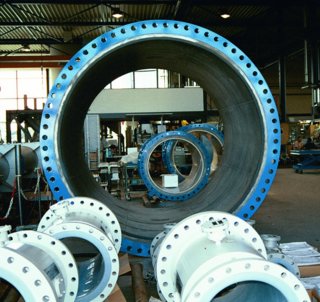|
|||
|
|
Overview of Magnetic Flowmeters |
 Magnetic flowmeters are among the most widely used types of flowmeters for
measuring the flow of water and other liquids. They have been around for more
than fifty years. The Tobinmeter Company first introduced magnetic flowmeters
for commercial use in Holland in 1952. Foxboro introduced them to the United
States in 1954. Since this time, more than 35 suppliers worldwide have come to
offer magnetic flowmeters for sale.
Magnetic flowmeters are among the most widely used types of flowmeters for
measuring the flow of water and other liquids. They have been around for more
than fifty years. The Tobinmeter Company first introduced magnetic flowmeters
for commercial use in Holland in 1952. Foxboro introduced them to the United
States in 1954. Since this time, more than 35 suppliers worldwide have come to
offer magnetic flowmeters for sale.Magnetic flowmeters generate more revenues worldwide than any other type of flowmeter. Revenues from magnetic flowmeters exceed revenues from all other flowmeter types, including Coriolis, positive displacement, turbine, and differential pressure (DP) types. The story is different in terms of units, however. More positive displacement, turbine, DP, and variable area flowmeters are sold annually than are magnetic flowmeters. Despite this, the higher average selling price of magnetic flowmeters enables them to generate more revenues annually than these other types of meters.
Magnetic flowmeters are most widely used in the water & wastewater and chemical industries. About half the revenues generated by magnetic flowmeters are due to sales into these industries. These meters are also widely used in the food & beverage and pharmaceutical industries, which often require flowmeters to conform to sanitary requirements. Flowmeter suppliers meet these requirements in part by placing sanitary liners inside the meters that make them suited for sanitary applications.
Magnetic flowmeters use Faraday’s Law of Electromagnetic Induction. According to this principle, when a conductive medium passes through a magnetic field, a voltage is generated. This voltage is directly proportional to the velocity of the conductive medium, the density of the magnetic field, and the length of the conductor. In Faraday’s Law, these three values are multiplied together, along with a constant, to yield the magnitude of the voltage.
Magnetic flowmeters use wire coils mounted within or outside of the meter body. A current is then applied to these coils, generating a magnetic field. As the conductive liquid passes through the body of the meter, a voltage is generated and detected by electrodes, which are mounted on either side of the meter body. The flowmeter uses this value to compute the flowrate.
Magnetic flowmeters are used to measure the flow of conductive liquids and slurries, including paper pulp slurries and black liquor. Their main limitation is that they cannot measure hydrocarbons (which are nonconductive), and hence are not widely used in the oil & gas and refining industries. Magmeters, as they are often called, are highly accurate and do not create pressure drop. Their initial purchase cost is in the medium range, and comparable to the cost of vortex flowmeters. Magnetic flowmeters typically cost more than positive displacement and turbine flowmeters, but they cost significantly less than Coriolis and ultrasonic flowmeters.
For more information on recent
developments in the magnetic flowmeter market, along with a quarterly update on
every flow technology, see Flow Research's quarterly Market Barometer. More
details are available at www.worldflow.com.

Flow Research, Inc.
27 Water Street
Wakefield, MA 01880
(781) 245-3200
(781) 224-7552 (fax)